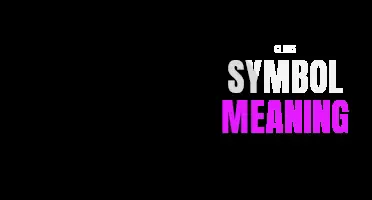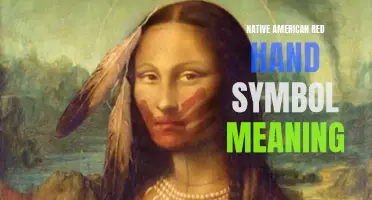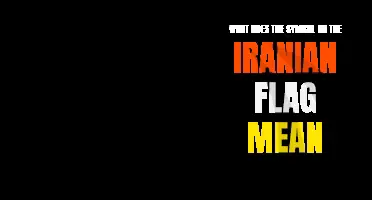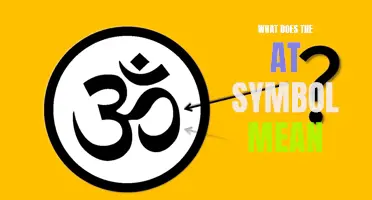
The palm symbol holds a significant meaning in various cultures and religions throughout history. Widely recognized as a symbol of victory, peace, fertility, and abundance, the palm has been depicted in various art forms, religious iconography, and even used as a hand gesture. Associated with wisdom, strength, and resilience, the palm symbol has transcended time and continues to hold a powerful and meaningful presence in our lives.
What You'll Learn
- What does the palm symbol traditionally represent in certain cultures or regions?
- Is the palm symbol commonly used in any religious or spiritual practices?
- Are there any specific interpretations or meanings associated with the palm symbol in different contexts?
- Can the palm symbol be used as a form of communication or signal?
- How has the meaning or significance of the palm symbol evolved or changed over time?

What does the palm symbol traditionally represent in certain cultures or regions?
The palm symbol holds great significance and has been used to represent various meanings in different cultures and regions. Through the ages, this symbol has been associated with different concepts, such as power, protection, victory, fertility, and spirituality. Let's explore how the palm symbol has been traditionally interpreted in certain cultures or regions.
Ancient Egypt:
In ancient Egyptian culture, the palm was considered a sacred tree and a symbol of resurrection and eternal life. It represented the goddess of fertility, Hathor, and was often depicted in the carvings and paintings found in tombs and temples. The palm branch was also used as a hieroglyph to denote the concept of "year" or "lifetime."
Judaism:
In Judaism, the palm branch, known as the lulav, is an important symbol associated with the festival of Sukkot. During this festival, people hold the lulav, which consists of a palm branch, myrtle, and willow, and wave it in six directions to symbolize the presence of God everywhere. The palm branch represents the characteristic of righteousness.
Christianity:
In Christianity, the palm branch is often associated with the commemoration of Palm Sunday, which marks Jesus' entry into Jerusalem before his crucifixion. According to the Bible, people waved palm branches as a sign of joy and victory, welcoming Jesus as their savior. Palm branches are also sometimes used to symbolize martyrdom, resurrection, and spiritual victory.
Islamic Tradition:
In Islamic tradition, the palm tree is highly valued for its diverse uses as a source of food, shelter, and shade. It is mentioned in the Quran and is considered a symbol of abundance, prosperity, peace, and well-being. The Quranic paradise, Jannah, is described as having palm trees with dates among its blessings.
Native American cultures:
In various Native American cultures, the palm symbolizes protection, shelter, and hospitality. Palm fronds are used to create shade and cover, making them essential in arid regions. The palm tree represents resilience and adaptability to adverse conditions. It also has spiritual significance as a connection with nature and the natural world.
Mediterranean cultures:
In regions such as Italy, Greece, and Spain, the palm tree is often regarded as a symbol of victory, triumph, and success. The palm branch or palm leaf was used as a prize or honor awarded to athletes in ancient Greek games, such as the Olympics. The palm also has agricultural significance, representing fertility and abundance in these agricultural societies.
In conclusion, the palm symbol holds different meanings in various cultures and regions. From representing resurrection and eternal life in ancient Egypt to symbolizing victory and triumph in Mediterranean cultures, the palm has played an important role in cultural and religious traditions throughout history. Whether it is associated with spirituality, prosperity, protection, or victory, the palm symbol remains an enduring and significant emblem.
Exploring the Mystical Meanings Behind Magic: The Gathering Symbols
You may want to see also

Is the palm symbol commonly used in any religious or spiritual practices?
The palm symbol is widely recognized and utilized in various religious and spiritual practices across different cultures. The symbol holds diverse meanings and significance, often representing fertility, blessings, protection, and divine presence.
One of the most well-known uses of the palm symbol can be found in Christianity. The palm branch is often associated with Palm Sunday, commemorating Jesus' triumphal entry into Jerusalem. In this context, people wave palm branches to symbolize the welcoming of Jesus as the "King of Kings." The palm branches also represent victory and martyrdom, as they were laid before Jesus as he entered the city before his crucifixion. Additionally, palm leaves are used to create crosses and are displayed during religious ceremonies and processions.
In Hinduism, the palm symbol holds various meanings depending on the particular customs and traditions. In some parts of India, palm leaves are used as part of ritual worship, offering prayers to deities or ancestors. The palm symbolizes purity and divine presence. It is also associated with Lord Ganesha, the elephant-headed deity, who is believed to protect against obstacles and bring good fortune. In this context, the palm is often depicted as offering blessings and protection.
Similarly, in Buddhism, the palm symbol has sacred connotations. Lotus flowers, which are often depicted with palm leaves, symbolize enlightenment and spiritual purity. The palm is also associated with the mudra hand gesture, where the right hand faces forward with the palm open and upward, symbolizing generosity and compassion.
In various African cultures, the palm symbolizes fertility and abundance. Palm leaves are used in rituals and ceremonies related to childbirth, marriage, and other significant occasions. The palm is considered a sacred tree, believed to possess protective and healing qualities.
In Islam, the palm symbol holds deep spiritual significance. Palm trees are mentioned in the Quran and are associated with paradise and abundance. The Prophet Muhammad is said to have loved palm trees and would sit under them to deliver sermons. The palm is also mentioned in Islamic literature as a symbol of blessings and prosperity.
In conclusion, the palm symbol is commonly used in religious and spiritual practices worldwide. Its meanings vary across different cultures, representing fertility, blessings, protection, and divine presence. Whether in Christianity, Hinduism, Buddhism, African traditions, or Islam, the palm symbol serves as a powerful and sacred emblem. Its presence in rituals and ceremonies underscores its significance in connecting individuals to their faith and spirituality.
Understanding Color Symbolism: A Comprehensive Koi Fish Color Meaning Chart
You may want to see also

Are there any specific interpretations or meanings associated with the palm symbol in different contexts?
The palm symbol holds significant meaning in various contexts and cultures around the world. From ancient beliefs to modern interpretations, the palm symbolizes a range of concepts including peace, victory, wisdom, fertility, protection, and connection to the divine.
In many ancient civilizations, the palm was revered as a symbol of victory and success. In ancient Rome, for example, palm branches were given to triumphant warriors and athletes as a sign of their achievements. The palm was also associated with the goddess Nike, who represented victory and success.
In Christianity, the palm is often associated with Palm Sunday, the day that commemorates Jesus' entry into Jerusalem. On this day, palm branches are waved to symbolize peace and victory. The palm is also a symbol of martyrdom and is often seen in religious artwork, particularly alongside images of saints who were martyred.
In Hinduism, the palm is known as the "Hasta Mudra" and is associated with knowledge, wisdom, and divine blessings. The hand gesture known as "Abhaya Mudra," where the palm is raised and facing outward, is a symbol of protection and fearlessness. The palm is also associated with the Hindu goddess Lakshmi, who represents abundance and prosperity.
In some African cultures, the palm is seen as a symbol of fertility and the nurturing qualities of motherhood. It is often used in rituals and ceremonies related to childbirth and motherhood.
In palmistry, the art of reading palms, different lines and markings on the palm are believed to reveal information about a person's character, personality traits, and future. The lines on the palm, such as the life line, heart line, and fate line, are interpreted to provide insights into various aspects of an individual's life.
The palm symbol can also be found in jewelry and fashion, often as a decorative motif. It is used to create intricate designs in metalwork and is a popular choice for tattoos.
Overall, the palm symbol holds diverse interpretations and meanings in different contexts and cultures. It represents concepts such as victory, peace, wisdom, fertility, protection, connection to the divine, and insights into one's life. Whether worn as jewelry, displayed in religious ceremonies, or used for divination purposes, the palm symbol continues to hold significance and capture the imagination of people worldwide.
Exploring the Powerful Symbols and Profound Meanings of Faith
You may want to see also

Can the palm symbol be used as a form of communication or signal?
In many cultures around the world, hand gestures and signals are used as a form of non-verbal communication. One such gesture is the palm symbol. The palm symbol involves holding up one's hand with the palm facing outward. It can be used in various ways to convey different messages or signals.
One common use of the palm symbol is to indicate a stop or halt. This gesture is often used by traffic police officers or construction workers to direct vehicles or pedestrians to stop. By holding up their hand with the palm facing outward, they communicate a clear message that it is necessary to pause or halt.
Another use of the palm symbol is to signal for help or assistance. If someone is in need of aid, they can hold up their hand with the palm facing outward to attract attention. This gesture is recognized internationally as a universal call for assistance.
Additionally, the palm symbol can be used to convey the message of surrender or submission. In situations where an individual is being confronted or threatened, raising their hand with the palm facing outward can communicate a willingness to comply or give up, avoiding further conflict.
In some cultures, the palm symbol may also be used to greet others or show respect. By extending their hand with the palm facing outward, individuals show openness and a desire to engage in friendly interactions.
However, it is important to note that the interpretation of the palm symbol may vary across different cultures and contexts. In certain regions or societies, this gesture may have different meanings or may not be recognized at all. Cultural sensitivity and awareness are essential when using hand gestures as a form of communication, as misunderstandings can easily arise.
In conclusion, the palm symbol can indeed be used as a form of communication or signal. Its various uses include indicating a stop or halt, signaling for help or assistance, conveying surrender or submission, and greeting others. However, cultural context and awareness are crucial in understanding and interpreting these gestures correctly.
What Does the Apple Weather Symbol Mean?
You may want to see also

How has the meaning or significance of the palm symbol evolved or changed over time?
The palm symbol has a rich history that spans across various cultures and civilizations, and its meaning and significance have evolved and changed over time. From ancient times to the present day, the palm symbol has held different interpretations and connotations in different contexts.
One of the earliest known depictions of the palm symbol can be traced back to ancient Egypt. The palm branch was associated with the goddess Isis, who was often depicted holding a palm branch as a symbol of victory and triumph. In ancient Greek and Roman cultures, the palm branch was also a symbol of victory and was awarded to victorious athletes and military commanders.
In Christian iconography, the palm symbol took on a new significance. It became associated with martyrdom and was often depicted alongside saints and martyrs who had died for their faith. The palm branch was seen as a representation of the victory of the soul over death and suffering. This symbolism is still seen today in Christian art and architecture.
During the Middle Ages, the palm symbol became associated with pilgrimage. Pilgrims returning from the Holy Land would often bring back palm fronds as a sign of their journey. These palm fronds would be displayed in churches and cathedrals as a symbol of devotion and spirituality.
In more recent history, the palm symbol has taken on a different meaning. It has become a symbol of peace and reconciliation. After World War II, the United Nations adopted the palm branch as part of its emblem to represent peace and disarmament. The palm symbol has also been used in various peace movements and protests around the world as a sign of non-violence and unity.
Today, the palm symbol continues to evolve and adapt to new contexts. It is often seen as a symbol of hope, renewal, and growth. It is used in various eco-friendly and sustainable initiatives as a symbol of environmental awareness and conservation. In some cultures, the palm tree itself is seen as a symbol of abundance and prosperity.
In conclusion, the meaning and significance of the palm symbol have changed and evolved over time. From victory and martyrdom in ancient times to peace and reconciliation in the modern era, the palm symbol has taken on different interpretations and connotations. However, it continues to hold a powerful and universal message of hope, growth, and harmony.
The Intriguing Meanings Behind Magic: The Gathering Symbols Revealed
You may want to see also
Frequently asked questions
The palm symbol is a universal symbol of peace, abundance, and victory. It is often depicted as an open hand with extended fingers and an upward-facing palm. This symbol has been used in various cultures and religions throughout history to represent blessings, protection, and good fortune.
Yes, the palm symbol holds different meanings in different cultures and religions. In ancient Egypt, the palm symbol represented the god Heka, who was associated with healing and magic. In Christianity, the palm symbol is often associated with Palm Sunday, which commemorates Jesus' entry into Jerusalem. In Hinduism, the palm symbol is known as the "Abhaya Mudra" and represents fearlessness and protection.
Yes, there are variations of the palm symbol depending on the cultural or religious context. For example, in some depictions, the palm symbol may include an eye in the center of the palm, symbolizing protection and warding off evil. Additionally, some versions of the palm symbol may include other elements such as flowers or animals, further adding to the symbolic meaning.
Yes, the palm symbol can be used as a personal talisman or amulet to bring blessings and protection. Many people wear jewelry or carry keychains or charms in the shape of the palm symbol to attract positive energy and ward off negative influences. It can also serve as a reminder to stay peaceful and open-minded in daily life.
There are several ways to incorporate the palm symbol into your daily life. You can wear jewelry adorned with the palm symbol, such as necklaces, rings, or bracelets. You can also display artwork or decorative items with the palm symbol in your home or office space to create a positive and peaceful atmosphere. Additionally, you can meditate or visualize the palm symbol, focusing on its qualities of peace, abundance, and victory, to attract those energies into your life.







